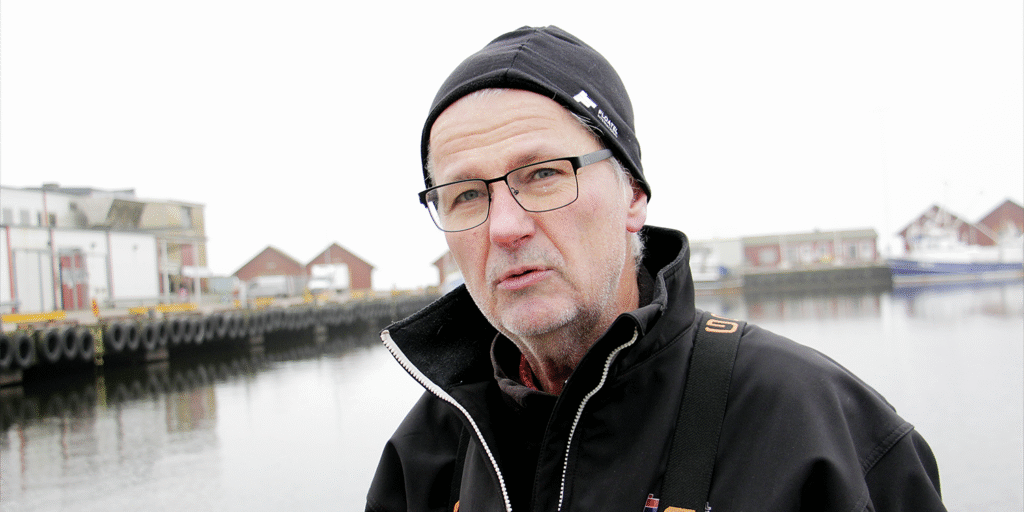
Easy-care product. – You don’t need to add energy, light or nutrients. It takes care of itself, says Nils Mårtensson at Swedish Kelp about seaweed farming.
In Asia, products like theirs are sold en masse. In Sweden, things are a little slower, although there is a clear niche here too.
– Sushi restaurants, says Nils Mårtensson at Swedish Kelp.
Down in the harbor in Glommen, Falkenberg Municipality, it is a typical February haze. Out on one of the piers, Nils Mårtensson stands, wearing galon trousers of the type you only see on real sailors. There, by the pier, he has one of the company’s experimental cultivations of sugar kelp.
– Right now we don’t have any production cultivation going on, he says.
Rope in the water
First in October it is time to lay out long ropes of about 30 to 40 hectares in Hakefjorden and Mollöfjorden, equipped with small blanks for what will become large seaweed sheets, about five kilograms per meter of rope that are anchored at a depth of 20 to 30 meters. The last time they cultivated, in 2023, they laid out 2.5 kilometers of rope, this year they are aiming for 4 kilometers.
The mother plants for the test cultivation in Halland are picked by Nils Mårtensson and his colleagues themselves in the spring, in the sea a little outside Glommen harbor.
– We take the boat and look for them, he says.
In a couple of hours, two or three people have the job done, after which they can create kilometers of rope that they lay out in the waters north of Glommen. The harvest takes place in April.
The connection to C2B2 – in which Swedish Kelp is an interested party – is pretty obvious. Seaweed farming is one of the businesses that compete for the marine environment. But Nils Mårtensson also has a burning interest in structured oceanographic data, and that’s how he first came into contact with C2B2’s program manager Torsten Linders.
– He also runs the Ocean Data Factory project, and that’s how we got in touch
Previously, Swedish Kelp was part of the company Kobb, which takes care of the raw material. But in 2023, they divided the company into a raw material part, Swedish Kelp, and a processing part, Kobb – both based in the same factory building in Glommen. The idea behind the division was to be able to concentrate the different businesses, plus Swedish Kelp can continue to experiment without being tied to delivering certain volumes.
Plenty of garlic and soy
Kobb processes the sugar kelp into things like wakame, a type of seaweed that many sushi restaurants offer as an extra. About ten tons a year come out of Kobb’s factory. Then the seaweed is boiled and shredded, marinated with flavorings such as garlic and soy. Delicious, most sushi eaters think.
– But most things taste good with garlic and soy, says Nils Mårtensson, who himself likes to eat the final product.
– Although you shouldn’t eat more than 100 grams a week, he says.
Among other things, seaweed has a lot of iodine in it, especially before it is processed. 95 percent disappears when it is blanched. Humanity became aware of the iodine thing during World War II when sugar seaweed was used to thicken dough for bread in Norway, among other places. Iodine is stored in the thyroid gland, which is also the reason why everyone living near Ringhals has iodine tablets in their kitchen cabinets. Should a serious accident occur, the added iodine causes the thyroid gland to become saturated and not absorb the radioactive variant.
– Those who ate the bread became ill, says Nils Mårtensson.
Last season, Swedish Kelp had no cultivations in progress. But in 2025 they are investing again.
Looking towards Asia
So far, it is an experimental operation that produces a few tons a year, which the partner Kobb buys up. But Nils Mårtensson and his partners see a larger market far to the east.
– In Asia. To become profitable, we need to get to around 600 to 700 tons, but that is nothing in that market, he says.
They need at least 20 kronor per kilo to break even.
Nils Mårtensson is a civil engineer with a focus on roads and water, and has also taken a licentiate in hydrodynamics. In 2025 he will be 68, and like most of the others in the company, he has Swedish Kelp as a kind of unpaid leisure activity. Then they hire various services and equipment – including skippers and boats – for peak work, such as during harvest.
He says he is passionate about the idea of food production that requires minimal energy. During the cultivation period, the seaweed obtains its nutrients directly from the sea. All that is needed is what nature offers for free, such as sufficient salt water, nutrients and sunlight.
But he started his career in a less environmentally-oriented business.
– I worked at Arendalsvarvet and built oil rigs. We also built the icebreaker Oden, he says.
During his career as an engineer, he then had similar assignments, often focusing on products niched for the offshore industry. Among other things, the construction and operation of floating offshore hotels.
In the mid-2010s, he started in his new industry.
– Sustainable food production is something the world needs more of, he says.
Today, Nils Mårtensson puts all his education and experience into it.
Facts: Nils Mårtensson
Age: 68 years.
Occupation: Partner and CEO of Swedish kelp.
Lives: Gothenburg.
Family: Wife, three children, three grandchildren.
Interests: I enjoy being at sea, I fish a lot. (Brandskär).
Listens to: Rolling Stones.
Drives: Volvo V70 2004.
Facts: Swedish kelp
The company was founded in 2018, and was spun off from the food producer Kobb in 2023. The company is headquartered in Gothenburg and is run by five partners.